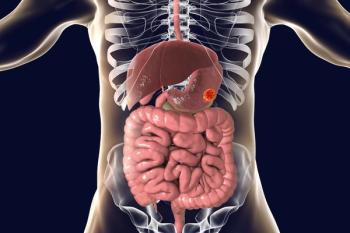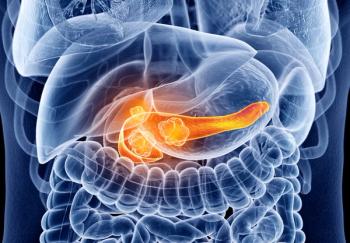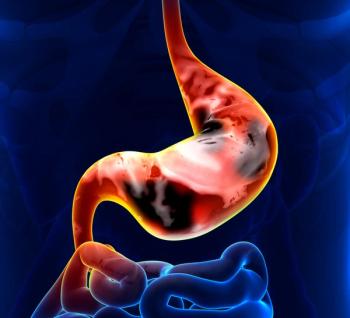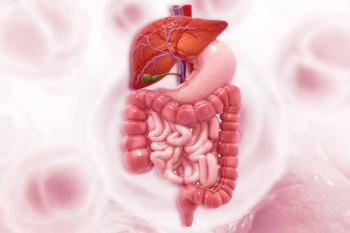
- ONCOLOGY Vol 14 No 10
- Volume 14
- Issue 10
Impact of UFT on Tumoral TS and DPD Levels in Colorectal Cancer
This was an open lable, pilot translational clinical pharmacology study of a brief (7 day) course of UFT, 300 mg/m²/day, in combination with leucovorin, 90 mg/day, in six patients with newly diagnosed advanced colorectal cancer.
ABSTRACT: This was an open lable, pilot translational clinical pharmacology study of a brief (7 day) course of UFT, 300 mg/m²/day, in combination with leucovorin, 90 mg/day, in six patients with newly diagnosed advanced colorectal cancer. The primary objectives of the study were to examine the impact of this treatment course on the UFT targets which are thymidylate synthase (TS) and dihydropyrimidine dehydrogenase (DPD). The rate of tumoral TS inhibition after the 7-day UFT treatment sequence varied from 5% up to 31%. UFT treatment induced a constant and variable decrease in tumor DPD activity ranging from 13% to 60%. UFT treatment induced a constant increase in uracil concentrations both in plasma and tumors. FT, 5-FU and the metabolite fluoro-beta-alanine (FBAL) were found in plasma and tumors at variable concentrations; the highest drug concentrations were those of FBAL in plasma. The present translational clinical study provides data related to the in vivo pharmacological effects of UFT with a description of its impact on cellular targets. [ONCOLOGY 14(Suppl 9):35-37, 2000]
UFT is an active anticancer drug in patients with colorectal cancer.[1] UFT is composed of a fixed molar ratio (1:4) of tegafur and uracil. In this pilot study, with a translational clinical pharmacology design, previously untreated patients with advanced colorectal cancer (Table 1) were treated with UFT plus oral leucovorin (a combination being developed under the trade name Orzel). Patients were treated for 7 days with UFT (300 mg/m²/d) plus leucovorin (90 mg/d) in three daily doses. The patients enrolled in this study were candidates for partial or total resection of tumor.
Tumor and blood samples were obtained less than 1 week before drug administration and within 1 to 4 hours after the last drug intake (at time of tumor resection). Approval was obtained from the local ethics committee and all patients gave informed consent.
Thymidylate synthase (TS) levels were determined by a slightly modified FdUMP binding assay,[2] and dihydropyrimidine dehydrogenase (DPD) activity was determined by radioenzymatic assay, using (14C) fluorouracil (FU) as substrate.[3,4] Drugs and metabolites were measured by gas chromatography and mass spectrometry (5-FU, m/z = 301; uracil, m/z = 283; fluoro-b-alanine [FBAL], m/z = 278) or by high-performance liquid chromatography (tegafur).
Table 2 shows the impact of the 7-day UFT treatment on tumor thymidylate synthase levels (FdUMP binding) and dihydropyrimidine dehydrogenase activity. The rate of tumoral inhibition after the 7-day UFT treatment sequence varied between 5% (patient 5) and 31% (patient 4). UFT treatment induced a systematic decrease in tumor dihydropyrimidine dehydrogenase activity ranging from 13% (patient 4) to 60% (patient 3). In comparison, the changes in lymphocytic dihydropyrimidine dehydrogenase activity were less consistent (only three of six patients exhibited a marked decrease after UFT treatment).
Table 3 illustrates the patient-to-patient variations in drug concentrations. UFT treatment induced a systematic increase in uracil concentrations both in plasma and tumors. Tegafur, 5-FU, and FBAL were found in plasma and tumors at variable concentrations; the highest drug concentrations were those of FBAL in plasma.
This pilot study demonstrated that a short, 7-day sequence of UFT treatment is able to induce measurable and variable effects on thymidylate synthase intratumor activity, resulting in 5% to 31% occupation of thymidylate synthase binding sites and a 13% to 60% decrease in intratumor dihydropyrimidine dehydrogenase activity. Drug and metabolite concentrations were detected at variable levels in both plasma and tumor, with FBAL exhibiting the highest concentrations in plasma.
References:
1. Sulkes A, Benner SE, Canetta RM: Uracil-Ftorafur: An oral fluropyrimidine active in colorectal cancer. J Clin Oncol 16:3461-3475, 1998.
2. Omura K, Kawakami K, Kanehira E, et al: The number of 5-fluoro-2-deoxyuridine-5-monophosphate binding sites and reduced folate pool in human colorectal carcinoma tissues: Changes after tegafur and uracil treatment. Cancer Res 55:3897-3901, 1995.
3. Harris BE, Song R, Soong SJ, et al: Relationship between dihydropyrimidine dehydrogenase activity and plasma 5-fluorouracil levels with evidence for circadian variation of enzyme activity and plasma drug levels in cancer patients receiving 5-fluorouracil by protracted continuous infusion. Cancer Res 50:197-201, 1990.
4. Beck A, Etienne MC, Cheradame S, et al: A role for dihydropyrimidine dehydrogenase and thymidylate synthase in tumour sensitivity to fluorouracil. Eur J Cancer 30:1517-1522, 1994.
Articles in this issue
about 25 years ago
New Awards Spotlight Courage of Cancer Survivorsabout 25 years ago
Children’s Art Project at M. D. Anderson Cancer Centerabout 25 years ago
Settling on an Increased NCI Budgetabout 25 years ago
Computer Billing Standardabout 25 years ago
Ligand Receives FDA Marketing Clearance for Bexarotene Gelabout 25 years ago
Mayo Clinic Study Shows Patients Uncertain About Cancer Risk Termsabout 25 years ago
Multidisciplinary Management of Pediatric Soft-Tissue SarcomaNewsletter
Stay up to date on recent advances in the multidisciplinary approach to cancer.

















































































